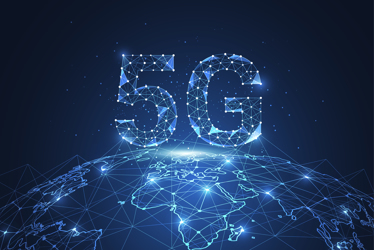4 Things You Need To Know About 5G's Massive Potential

By John Oncea, Editor

RF and 5G. Two great tastes that go great together. No, wait. That’s a Reese’s Peanut Butter Cup.*
But these two technologies, working in tandem, are going to do great things! Improved network coverage! Increased data capacity! Better spectral efficiency. Ultra-low latency! Yay!
Well, it’s not going to be all fun and games. There will be greater complexity in modulation and demodulation. Problems related to signal interference. Security risks due to the use of multiple antenna systems for increased coverage and data throughput. Boo.
Despite these challenges, 5G network technology and RF are going to revolutionize the way we communicate; 5G by delivering more speed and more reliable connections and RF doing things such as solving line-of-sight problems. Still, issues such as cost and compatibility with existing equipment could slow the deployment and adoption of these technologies.
But the payoffs – improved coverage, greater reliability, faster communication speeds, and easier remote access – are too good to be ignored.
It’s obvious this is going to happen. Heck, it’s happening now. So, let’s take a look at how things might go moving forward.
* Full disclosure – Reese’s Peanut Butter Cups are a garbage candy. There, I said it. Someone had to.
Since 5G Is Inevitable Here Are 4 Things To Think About
- Julie Song, president at Advanced RF Technologies (ADRF), writes for Forbes that 5G needs widespread deployment of macro networks if it’s going to have significant in-building growth. “Sprawling macro networks will act as a catalyst for more 5G indoor deployments (as it has in previous wireless generations), particularly for mid and low-band like C-band, 2.5GHz, and 600MHz,” writes Song. “Since more than 80% of cellular connections begin and end indoors, it will effectively signal 5G’s mainstream arrival, similar to how we now view 4G/LTE as ubiquitous and ever-present.”
- Edge computing, according to Light Reading, is going to capitalize on 5G innovation to deliver breakthroughs. “Edge computing eliminates the processing delays typical of traditional networks by processing data at the network’s periphery using 5G base stations,” writes Light Reading. “For example, the edge eliminates latencies associated with relaying information to a data center while enhancing overall scalability and improving resource utilization.” Leveraging the wireless network model, edge computing platforms deployed from within a 5G base station for real-time processing of business data will offer both low cost and reduced energy consumption. This will eliminate the need for equipment rooms, power supplies, transmission links, and other auxiliaries.
- Investopedia writes that there is money to be made but betting on 5G’s future success but, like all investments, it will be tricky. “Investors can target 5G in their investments by focusing on individual telecommunications companies involved in 5G infrastructure and access,” notes Investopedia. “They also can focus on companies indirectly involved in 5G, including makers of 5G-enabled technology.”However, they continue, “While it is transformative and presents exciting possibilities for investors, it does carry risks and likely will not be fully implemented for years to come. Still, a multitude of companies across many industries — ranging from internet service providers to automotive manufacturers to firms focused on artificial intelligence — stand to benefit from this technology.”
- Finally, regarding security, The Hill notes that what makes 5G a dramatic improvement over 4G is what is going to make it less secure as well. “The 5G architecture offers a mixed spectrum, but also the ability to slice the network; together they offer flexibility and adaptability, which is essential to serve a wider range of devices. Add to the mix the Multipole-Input, Multipole-Output (MIMO) ability, and you have a massive number of targets to attack.”
This risk is ramped up because of virtualization. The Hill explains this as, in essence, 5G replacing hardware-based network functions with dispersed, software-based ones. “One thing we know for certain is that any software can be hacked, and so the shift to software inevitably expands the surface of cyberattacks. Worse, if the virtualization layer is breached, all network functions come under direct attack with potentially disastrous consequences.”
Lastly, it remains to be seen if open-RAN (radio access network) – the technology that permits interoperability among RAN equipment from different vendors – is a dream or reality. If it’s real, “It could temper Huawei’s dominance, thus muting concerns about both China using 5G for intelligence purposes and fears that, as with 4G before it, the companies that dominate 5G will lead the standard-setting for it.”
5G is going to bring revolution and challenge, but the potential upside outweighs the risks. It will be incumbent on those building, operating, and using 5G networks to ensure that they are safe and secure for everyone involved. With proper security measures in place, 5G can become ubiquitous within a few short years. It could connect much of the world, revolutionizing business, entertainment, and communication as we know it. This is why industry experts are paying close attention to 5G technology and its potential for changing the way people use wireless connections. With its endless possibilities for innovation, 5G has the potential to be a game changer. The only question that remains is: Are you ready for 5G?
